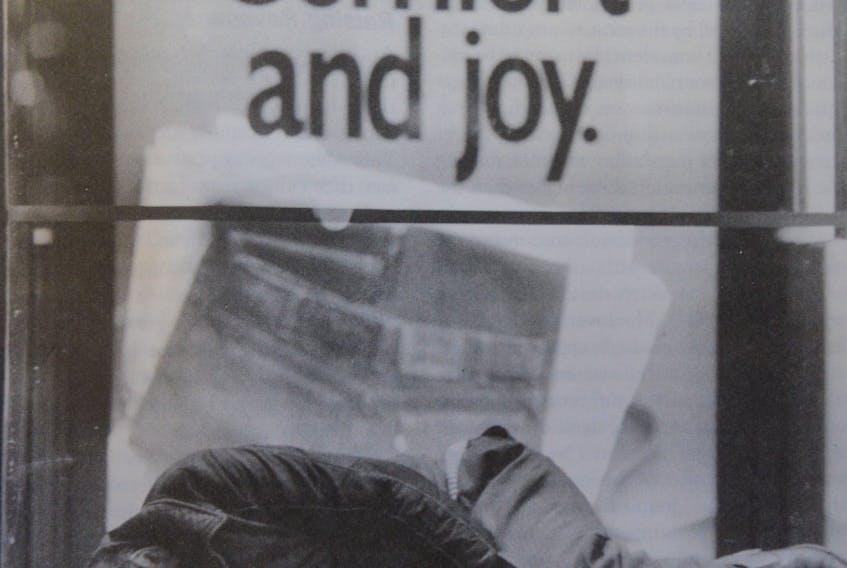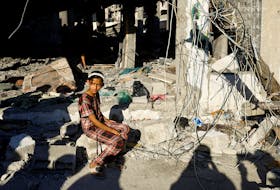The photo in this column wasn't taken in Cape Breton. It's a Christmas scene in front of a store in Ottawa. But the contradiction is glaring. Wishing the general public "Comfort and Joy" flies in the face of the man sleeping in that Ottawa bus shelter. As a homeless person he was not experiencing much comfort and joy. Indeed, he was cold and neglected, without a place to sleep safely.
Homelessness is just as painful here in the Cape Breton Regional Municipality (CBRM). In this season, where the focus is on warmth and comfort, most of us naively believe that everybody has shelter in a home on the island. In fact, if asked many Cape Bretoners don't think we have homelessness within the CBRM. We usually observe homelessness the same as in other Canadian communities. The homeless are not obvious everyday fixtures on the streets of the CBRM.
Being homeless in Cape Breton is troubling at anytime but it is more poignant at this time of year. People in this situation are trying to make the best of a bad situation not having a roof over their head at Christmas and the rest of the year. In some cases, homeless people are often ostracized from family and friends. And, just the thought of Christmas can bring unhappy memories of Christmas' past.
Last year, some local organizations began a rigorous count for the first time. A local point-in-time study was completed in April, 2016. It identified 304 people in various categories of homelessness in the CBRM: 137 people were without permanent residence, 10 people were without shelter, 93 were living temporarily with others, 85 were in emergency shelters, 28 were transitional, staying in motels and boarding houses, 88 were under treatment at an addiction centre.
Another point-in time count is expected in the near future.
In the 2016 point-in time tally more women than men were counted. Not surprisingly, First Nations were found to be over-represented. One in five was a young person under 24 years of age. About 25 per cent were over 55 years of age. Local organizations such as the Community Homeless Shelter, Transition House and Almost Home Shelter are a few of the eyes and ears of homelessness in the CBRM.
Last week, the Trudeau government announced its national housing strategy, a long-overdue federal initiative to attack poverty. For the first time prime minister acknowledged that housing is a "human right" and that Canadians have the right to affordable housing. The government's significant investment will be $40 billion over a 10-year period, establishing a strong federal presence in housing.
Part of the target of this federal investment is to reduce homelessness by 50 per cent. That remains to be seen.
What is not clear is what role the provinces will have to play. Most have been reluctant to make poverty, let alone homelessness, a budget priority. All provinces face increasing demands to invest more public dollars in education and health care. Nova Scotia is particularly challenged by the overwhelming demands in these two areas.
As noted above, the homeless are not everyday fixtures on our streets. We don't see them the way one does in Montreal, Toronto or Halifax. In Cape Breton, homelessness is not just a predictor of poverty it's a confirmation of its widespread presence at many different levels throughout the island. Homelessness is wrongly depicted as a separate and distinctive social problem. In fact, it's really another dimension of widespread poverty. The worsening presence of poverty is part of the failure of our governments to pay more than lip service to the poor and destitute living among us.
In our complex and perhaps outdated federal system there is the offloading of social responsibilities down through the levels of government until they hit the streets. Homelessness is where the rubber hits the road. The federal government is the only level of government with the resources to adequately address the issue of poverty across the country. The other levels can only tinker with manifestations of poverty and never do an adequate job.
The Canadian Centre for Policy Alternatives advises that 10 of the communities in Nova Scotia with the highest rates of child poverty are in Cape Breton. Last week the numbers were brought forward showing how poverty is so deeply entrenched among many Cape Breton families. Eskasoni, Membertou, Wagmacook and Whycocomagh are particularly vulnerable to poverty. Child poverty in these communities is among the highest in the country.
Homelessness dramatizes the poverty here, where women and children constitute the fastest growing segment of those who might become homeless at anytime. In the past, single men comprised the largest component of the homeless population. But now women outnumber men at 52-48 per cent as the majority of homeless on the island. Many of them simply cannot afford to pay rent and buy food on the income they receive from low wage jobs or social assistance.
But to separate homelessness from the general presence of poverty on the island is to misunderstand how pervasive the problem is.
Professor Jim Guy, PH.D, author and professor emeritus of political science at Cape Breton University, can be reached for comment at








